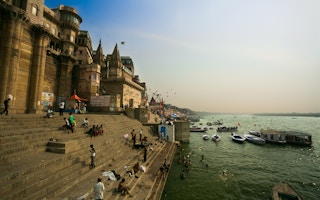The Ganges River - Ganga in Hindi - begins over 3,000 meters above sea level on the Indian side of the snow-capped Himalayan mountains, but for many its story begins in the matted hair of Lord Shiva.
How climate change is drying it up, how excessive damming is proving disastrous, how the pollution that has been reported on for decades is still occurring—these are simply not part of the ancient story.
As such, sound scientific data about the plight of the Ganga is often dismissed as nonsensical or is, in the context of politics, reframed into a more populous-friendly message such as what Prime Minister Narendra Modi said when he took office on May 26, 2014: “Mother Ganga needs someone to take her out of this dirt and she’s chosen me to do the work.
One NGO, the Delhi-based Observer Research Foundation (ORF), a nonprofit think-tank involved in regional and transboundary resource management of water, created the first social perception analysis to study the contentious, ideological divide between religion and rivers in India. In one thematic area of the study, 150 interviews and 500 surveys sought to glean the link between religious value and conservation efforts in the Ganga basin. What ORF published in their report titled “Attitudes towards Water in India” is troubling.
“A large number of respondents felt that the religious value of the Ganga was non-negotiable,” said Sonali Mittra, a co-author on the study. “Some respondents even suggested that the scale of traditional rituals such as corpse immersions in the Ganga were so low that they ‘did not really upset the ecological balance or biodiversity’ and that immersion of dead bodies in the river had in no way been found to hinder water management initiatives in the Ganga. The mythological idea of the Ganga is indeed more valued than the river itself.”
As the story goes, Ganga lived a happy life in the heavens. But when Sagara sent his 60,000 sons out to find a special horse, and in their quest they were all burned to death by Kapila, the disgraceful manner of these deaths meant that their souls would not be given salvation. This is when Bhagiratha, grandson of Sagara and therefore son of one of those 60,000, believed that if he could bring the holy river Ganga down to earth and even the netherworld that their souls would be released to heaven. Bhagiratha prayed to Brahma and Brahma accepted the request.
Ganga was insulted; she vowed to destroy every part of earth and the netherworlds as she made her descent. But Lord Shiva stood beneath the raging Ganga, and as she flowed through his hair and into earth and into the netherworlds her pace slowed down, her anger subsided and she was released as small streams. Regarded as the only river to flow through all three worlds, Ganga decided to stay on earth so she could purify those who came into contact with her.
Diverting attention from polluters
“
More than any of the world’s rivers, the Ganges contains multitudes. No river is as cared for and in need of caring. No river’s mythology is as intertwined into its hydrology. No river is as preserved by old stories and as desperate for new stories.
“In casting blame only on those who believe deeply in the mythological story,” said an ORF spokesperson, “we are diverting attention from the major polluters. It is generally seen that the poor or vulnerable river communities are the major polluters, but much research indicates that it is industries and urban centres who are more responsible.
Climate change lies at the interstice of food and energy security, industrial development and ecological degradation, and the International Water Resource Management Institute estimates that water demand in India will increase 32 per cent by 2050. If there has ever been a time to bridge the division between science and religion it is now. This is a frightening time for Mother Ganga and the nearly 500 million people who are sustained by her waters.”
More than any of the world’s rivers, the Ganges contains multitudes. No river is as cared for and in need of caring. No river’s mythology is as intertwined into its hydrology. No river is as preserved by old stories and as desperate for new stories. The Ganges is often talked about in the context of its juxtapositions—of deification and defecation, of the solemn and the fantastic, of prayers and pathogens—and it seems to hold these as well as it holds scenic row boats at dawn.
Except that it doesn’t. It can’t. And any indication that it can is a mirage. What the Ganga needs, aside from a legislative body truly dedicated to enforcing existing usage and pollution laws, is either a new story or the willingness from all parties to balance several stories simultaneously.
Cameron Conaway’s reporting on the Ganges River was supported by a grant from the Pulitzer Center on Crisis Reporting. This article was republished from Thomson Reuters Foundation.











